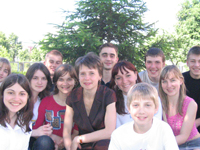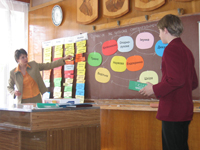Teaching in the Ukraine: Halyna Yagenska Inspire article
Halyna Yagenska tells Sai Pathmanathan about teaching in the Ukraine.

Image courtesy of Halyna Yagenska
Halyna Yagenska is no ordinary woman. Devoted mother of two and a teacher for 18 years, she works hard to improve science teaching in her home country, was named Best Ukrainian Biology Teacher in 2004 and was awarded the title ‘Honour Teacher of Ukraine’ by the president of the Ukraine. She tells Sai what she loves about teaching science, describes her efforts to link teachers with each other, and shares her hopes for science education in the Ukraine.
“There are no teachers in my family,” says Halyna. “As a child I dreamed of working at school. But then I also played a lot of sports and wanted to win an Olympic gold medal or even become an astronaut. Above all, I always loved learning new things and was lucky to have a biology and geography teacher who influenced me and trained me to win the all-Ukrainian school competition in science.” Halyna also remembers the input of her parents, who taught her to appreciate the natural world; this was one of the main reasons that she chose to study biology and geography at university. But it was during her studies, on the first day of her school placement (a compulsory part of all university degrees in the Ukraine – not just for future teachers), that she knew she had found her dream career: to be a teacher.
“I realised that teaching and especially interacting with kids suited me best. My first pupils were 11-12 years old and their natural curiosity inspired me. We used books on the history of science to write plays for school performances, presenting tales ranging from ancient Phoenicia to Columbus and Magellan.”
Teachers are naturally proud of students who do well, and Halyna remembers two students particularly clearly. “Two girls, Maria and Olena, had never previously stood out in lessons,” she recalls. “But in one of the first hands-on activities I organised in their first year of biology, something grabbed their attention. The task was to observe a drop of pond water under the microscope. They found not only the usual algae, Spirogyra and Chlamydomonas, but also two examples of Protozoa: Stentor and Vorticella. This was a greater variety than any of the other students had in their samples. Additionally, Maria and Olena observed fertilisation in Chlamydomonas in their sample: their bench became a ‘site of pilgrimage’, which they loved.”
This motivated Halyna too and she wanted to sustain their interest. The girls worked very hard for the next few months, also out of school hours, to breed plankton and identify the species they found. They even devised an experiment to test whether a washing powder advertised as the ‘least harmful washing powder to organisms in natural ponds’ really was. Maria and Olena prepared dilutions of four brands of detergents and added them to containers with two species of Crustacea. They collected results all through the night. It turned out that the least harmful detergent wasn’t the one advertised as such. Surprise, surprise. The girls presented a paper in Lutsk and in the capital, Kyiv, at the National Ecology Congress for School Students. Halyna continues to be proud of her students, both of whom are now studying biology at prestigious universities in the Ukraine.
Of course, no teacher’s job is without its challenges. Halyna finds there is still a huge gap between educational reform and society’s attitude to education. “Parents still have an old-fashioned view about education. They make their children memorise and recall facts and knowledge, without really getting involved in their education. Also, students have different needs and interests: in the Ukraine, even the older school students cannot choose which subjects they learn, which can make it difficult to interest them in a subject they will not need for their chosen career. In the same class, I have students asking me ‘why do I need to study this?’ and others who want to study concepts in more depth. It’s a real challenge to keep the balance – to make sure one half doesn’t lose their interest in biology, and the other half is not deterred from a scientific career.” Halyna tries to involve her students – all of them – in the scientific world by making them researchers, not only of science but of the world around them.
“The reason why parents don’t appreciate the need to develop their children’s scientific reasoning is probably because they only remember their own education. Ten years ago, the state education system in the Ukraine was very different. The task was to overload students with data, offer very little practical work and make them memorise scientific terminology.” The system is still rigid, but things are getting much better. “Nowadays every teacher can modify up to 30% of the content approved by the Ministry of Education and Science. In my opinion the optimal format is if the state authority sets up general guidelines with clear criteria of what is needed for exam success but then leaves it to the teacher to work out ways to achieve it.”
Halyna is also optimistic about other changes being made by the Ministry of Education and Science. They are now more receptive to teachers’ and students’ needs and are testing new formats and approaches to encourage competence rather than knowledge accumulation in classroom science. These days, for example, new school books and programmes are written by teachers: the plans are submitted in a competition. Halyna is enthusiastic about this way of motivating students and many of her ideas have been accepted.
A significant breakthrough in the last five years has been the all-Ukraine tournaments for school teams to debate the most advanced scientific theories and unsolved problems. They begin at a local level, with the winning teams going on to regional games and finally to the national level. The list of topics is distributed by the Ministry a few months in advance and teams of students (guided by their teacher) prepare for ‘battle’ using all the sources they can find. Every member in the team plays a different role – presenting, defending and opposing particular ideas – but no one knows which role they will be assigned until the day of the competition. Example topics include:
- Imagine a situation in which gravity increases by 25%. How would mammals adapt?
- A gene associated with alcoholism (GABRA 2) is found in populations around the world, but the prevalence of alcoholism differs between nations. Explain this phenomenon.
“I see how much enthusiasm it sparks among my pupils and I am very glad they can realise their potential,” says Halyna. “They work hard, reading complex material and extracting the essentials to build up their argument whilst all the time developing teamwork and presentation skills and even learning to control their emotions when debating.” These tournaments have also shown Halyna the value of being able to meet and swap ideas and experiences with teachers from other parts of the Ukraine.

Image courtesy of Halyna Yagenska
Halyna is still in contact with many of her former pupils. At the beginning of their university degrees, many of them come back to school to ask for books, advice or support but she has noticed that, after a while, the relationship changes: they bring new books and materials to update the school. Some even choose the school for their compulsory teaching placements.
“Pupils love interesting facts and cutting-edge science and they are receptive to the ‘word of the scientist’. Real scientists can show them how scientific knowledge is acquired: how an original hypothesis evolves into solid knowledge. Scientists can also give us contemporary examples of wrong assumptions that were ruled out, helping our pupils to develop critical thinking.” Her former students also benefit from the visits: “They learn skills such as how to present material in an easily understandable manner and how to illustrate their points clearly using diagrams and tables.”
But it’s not all about the students, past or present. Adequate support facilities for teachers are also needed. Two years ago Halyna took part in a three-day workshop for teachers, organised by the European Learning Laboratory for the Life Sciences (ELLS)w1 based at the European Molecular Biology Laboratory (EMBL) in Heidelberg, Germany, and felt it was one of the best she had ever attended. “First of all it was the feeling of being exposed to true cutting-edge science. Not only did the very advanced facilities impress me, but the realisation dawned on me that the life sciences have become more and more influential in shaping our civilisation.”
After the workshop, Halyna and her colleagues organised a series of workshops in the Ukraine with help from ELLS to pass on what they had learnt to other teachers and education professionals and to share materials and experiences. “Being a trainer is much more challenging than being a participant,” says Halyna. “We felt a greater responsibility as we had to teach our colleagues, some of whom hold senior positions. These people can influence the curriculum and it felt like a chain reaction: scientists talking to teachers, who talk to local union managers… all to help students. It was so different to my daily routine of teaching.”
Halyna has also created the learning network for biology teachers in the western Ukraine using knowledge and skills she picked up in Heidelberg. More than 20 teachers in seven regions of western Ukraine form the backbone of this network, and share information with colleagues through seminars. In Halyna’s Volyn region, materials and practical experiments (e.g. DNA extractions) were presented to over 150 biology teachers. Halyna values the support of scientists in establishing this network; “In particular, one Ukrainian scientist then working at EMBL, Tetyana Klymenko, launched the process of knowledge sharing and the creation of the national network”, she explains.
If Halyna was able to put European Union (EU) money to good use for the benefit of teachers and students, what would she do? “The most important part of any project would be the exchange of experience. If the best teachers, scientists and policy-makers from the EU could share their experiences with Ukrainian teachers and students it would be great, and would also improve teachers’ and students’ English skills.”
Halyna feels that one of the biggest problems in the Ukraine is the lack of fluency in English. “In the Soviet Union, it was state policy to restrict our ability to communicate with people from other countries. The policy in the Ukraine is now very different but it will take a while for the language skills to catch up.” Halyna is keen to help: together with English teachers at her school, she runs biology lessons in English. “This integrated approach motivates students to learn both biology and English,” she explains.
Like most teachers, Halyna is not afraid of hard work. Especially if it means getting involved in award-winning projects. She organised a school scientific club, which has now been running for more than ten years. Students choose the research they are interested in carrying out, and as a result they have won regional and national research competitions – with some of the data being published in scientific journals and scientific conferences as far away as Prague (Czech Republic), Milan (Italy), and Washington DC (USA). Studies investigated, for example, blood pressure in school children, autonomic regulation in adolescents, and the impact of pollution on river plankton. This is a particularly proud achievement for Halyna, as many members of the club went on to choose science as their career.
Clever pupils? Probably. Inspiring teacher? Definitely.
Web References
- w1 – The European Learning Laboratory for the Life Sciences (ELLS) is an education facility to bring secondary school teachers into a research laboratory. Based at the European Molecular Biology Laboratory in Heidelberg, Germany, ELLS welcomes European teachers to its free three-day practical workshops. See www.embl.org/ells/ for further details.





